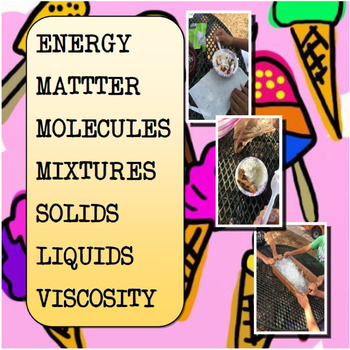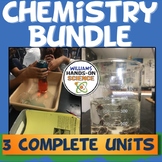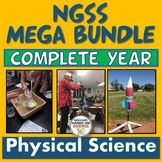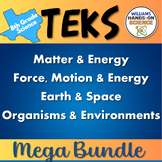Matter Molecules Energy Ice Cream Lab Reading Cloze Notes NGSS PS1.A PS3.A
- PDF
What educators are saying
Also included in
- This NGSS bundle has everything you need for Structure and Properties of Matter (complete distance learning unit), PS1.B PS3.A Chemical Reactions Google Ready Bundle (complete distance learning unit) Chemical Reactions, Definitions of Energy, States of Matter, Periodic Table, Chemical Reactions, ConPrice $69.97Original Price $115.20Save $45.23
- This bundle is a time-saving, comprehensive and user-friendly complete year bundle for physical science Teachers that will streamline your teaching experience effortlessly! Every lesson is meticulously planned and just a click away. This extraordinary bundle is a treasure trove of engaging resourcesPrice $176.00Original Price $311.50Save $135.50
- The TEKS 8th Grade Bundle is a comprehensive resource for teaching science mainly in Texas, but it can be used in any state. This bundle includes over 60 hands-on, rigorous, engaging, and phenomena-driven lessons that cover the TEKS standards for 8th grade science. The lessons are designed to help sPrice $160.00Original Price $321.15Save $161.15
Description
I have done this lab since 2000 and it is the most memorable lab that I do. I have former students that are now adults that remember this lab. I don’t buy any of the ingredients, we discuss it days before and the students get in groups to decide who brings in what ingredients. On the day of the lab I have students bring in their materials in the morning and I have 5 different coolers for my five different periods. I only have them place what needs to stay cold in the cooler and rest of the ingredients they keep with them until they arrive to my class. However, when I do this lab in my summer school special ed. class I just purchase the materials using department money. What I provide are buckets large enough to fit a 7-10lb bag of ice in.
I provided background information on the science behind the chemistry of ice cream as well as a YouTube clip from the American Chemical Society that’s entertaining and informative, so you won’t need to lecture or provide much scaffolding leading into this lab.
The directions are easy to follow but I’d still model the lab and the two biggest mistakes students make are putting too much vanilla in their ingredients and getting salt in their ingredients. This is why I use two zip-lock bags to ensure no salt gets in ice cream and that they rinse the salt off the bags once their ingredients have solidified. Salt will absolutely ruin their ice cream!!!
This lab is great for mainstream, special ed. and English Language Learners, there is a flow chart and fill in the blank paragraph with a word bank. This Lab includes the following concepts:
-Energy and energy flow
-Solids
-Liquids
-Molecules
-Crystalline Solids
-Amorphous Solids
-Mixtures
-Polymers
Please give feedback, review on TPT and email me with any ask questions: craigwilliams4291@gmail.com
Thanks so much!!!








